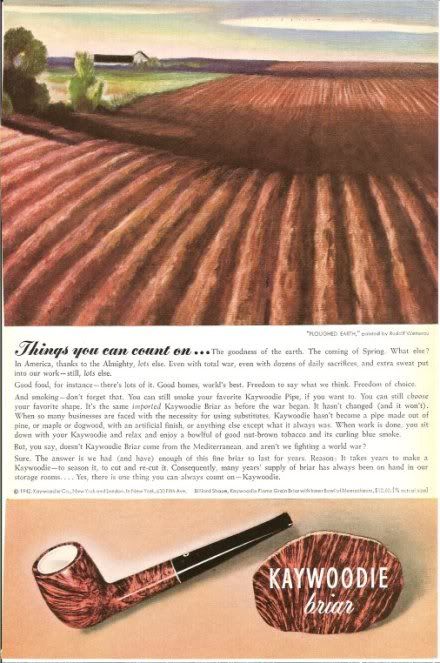Rudolf Wetterau (1890-1953) was a commercial artist specializing in landscape and still life paintings. Several of his works were used for Kaywoodie ads during the 1940s.
If you read the writing on this ad, you can see how it specifically refers to the situation during World War II.
Things you can count on...The goodness of the Earth. The coming of Spring. What else? In America, thanks to the Almighty, lots else. Even with total war, even with dozens of daily sacrifices, and extra sweat put into our work--still, lots else.The ad goes on to discuss the situation with briar during the war. There were no ships available, nor was it even safe, to import Mediterranean briar during the war. And thus was born that little stamp with which all pipe smokers are now familiar: "IMPORTED BRIAR." To most this probably only seems to be some odd, nonsensical sales gimmick. After all, all briar is imported.
Good food, for instance--there's lots of it. Good homes, world's best. Freedom to say what we think. Freedom of choice.
And smoking--don't forget that. You can still smoke your favorite Kaywoodie pipe, if you want to.
The IMPORTED BRIAR mark began during World War II so pipe smokers would know their pipe was made from the good stuff. Some U.S. pipe companies ran short of briar during the war, when none was being imported. So there were many pipes made from other materials, some of which worked, some of which didn't work so well, but none of which worked as well as imported briar. Maple, olive and cherry wood can make passable pipes, but some other experiments were distastrous. For example, there were attempts made to create pipes from American briar. Unfortunately, the briar that grows on the American continents is not the same as that which grows in the Mediterranean area and is not suitable for pipe-making by any means.
Kaywoodie had enough briar warehoused to last for several years, and they and some other makers wanted to make sure their customers knew that their pipes were still made from good Mediterranean briar. So today we still have thousands of pipes stamped with IMPORTED BRIAR.
As for the pipe pictured in this ad, this was a top-of-the-line meerschaum-lined Flame Grain that sold for a whopping $12.50 in 1942 (equivalent to $157 today, adjusted for inflation). Lining the inside of a briar bowl with meerschaum is just a gimmick (in my opinion, of course), it does not improve the smoking qualities of a pipe, especially a pipe like the Flame Grain that was made from better-than-usual-quality briar. But smaller chunks of meerschaum that were not big enough to be made into a pipe had to be used for something, or the money that bought them would be wasted. Turning them into small liners for briar pipes gave them one more sales strategy. In fact, I'm not sure these liners were made from block meerschaum. They may have been made from pressed meerschaum, created from the cast-off shavings from carving a meerschaum pipe. In either case, this was only a way to save some material rather than throw it away.
Of course, meerschaum-lined briar pipes are still being made, because it's a gimmick that still sells pipes.


But would lining a briar pipe with meerschaum reduce the "break-in" period needed with briar?
ReplyDeleteI suppose that's correct, but I've never understood why some pipe smokers so badly want to avoid the break-in period.
ReplyDeleteI'm not sure... I feel it's all part of the art. Taking the time to do something well. Keep up the posts, really enjoying them!
ReplyDelete